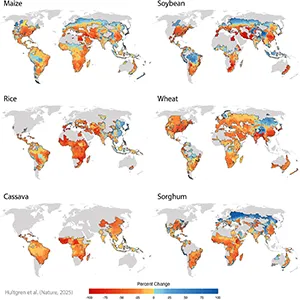Russia’s wheat harvest halves amid slow pace and low yields – TradingView

Report on Russia’s 2025 Wheat Harvest and its Implications for Sustainable Development Goals
Executive Summary: A Threat to Global Food Security and Climate Resilience
A significant decline in Russia’s wheat harvest has been reported, with output as of July 11 plummeting to less than half of the previous year’s figures. This shortfall presents a direct challenge to the achievement of Sustainable Development Goal 2 (Zero Hunger) by threatening the stability of global grain supplies. The primary causes, including adverse weather and drought, underscore the profound impact of climate-related disruptions on agriculture, highlighting the urgent need for measures aligned with SDG 13 (Climate Action) and SDG 15 (Life on Land).
Analysis of Harvest Output and Yields
Initial data indicates a severe lag in Russia’s wheat production, attributed to a slow harvesting pace and low initial yields. This situation jeopardizes Russia’s economic stability in the agricultural sector, impacting SDG 8 (Decent Work and Economic Growth).
- Total Harvest: 11.0 million metric tons have been harvested as of July 11, compared to 24.8 million metric tons by the same time in the previous year.
- Harvesting Progress: The current pace is 56% behind last year’s figures.
- Area Harvested: 3.2 million hectares have been harvested, significantly below the 6.2 million hectares from the previous year and the average of 4.1 million hectares.
- Average Yield: Current yields are 3.4 metric tons per hectare, a decrease from 4.0 metric tons per hectare in the prior year.
Climatic Factors and Environmental Impact (SDG 13 & SDG 15)
The harvest shortfall is intrinsically linked to environmental and climatic factors, demonstrating the vulnerability of food systems to climate change.
- Drought Conditions: Lower yields are concentrated in the drought-stricken southern regions of Rostov and Krasnodar. This severe weather directly impacts land productivity, a key concern of SDG 15 (Life on Land), which aims to combat desertification and halt land degradation.
- Extreme Heat: Persistently hot and dry weather, with projected temperatures soaring to 40°C, poses a substantial threat to remaining crops. These extreme weather events are a clear manifestation of the challenges addressed by SDG 13 (Climate Action) and its call for urgent action to combat climate change and its impacts.
- Regional Disparities: In contrast, the region of Stavropol has reported slightly higher yields due to more favorable weather, illustrating the critical role of stable climatic conditions in maintaining agricultural productivity.
Implications for Sustainable Development Goal 2: Zero Hunger
As a major global wheat exporter, Russia’s production difficulties have direct and significant consequences for global food security, undermining the core objectives of SDG 2.
- Threat to Global Supply: A substantial reduction in Russia’s output can disrupt international grain markets, affecting the availability of a staple food source for millions worldwide.
- Risk of Price Volatility: Supply shortages often lead to price instability, which can make essential food items unaffordable for the most vulnerable populations and reverse progress made in eliminating hunger.
- Food System Fragility: This event highlights the fragility of global food supply chains and reinforces the need for resilient agricultural practices and international cooperation to ensure stable and equitable access to food for all.
Official Forecasts and Market Outlook
Despite the current challenges, official forecasts provide a broader perspective on the season’s potential outcome. These projections are vital for policymakers and organizations working to mitigate risks to SDG 2.
- USDA Forecast: The United States Department of Agriculture (USDA) projects Russia’s total wheat production for the season to be 83.5 million metric tons. This figure serves as a crucial benchmark for global food security analysis.
- Expert Outlook: Analysts note that while the harvest gains momentum and may see improved yields as it expands beyond the drought-affected South, the risk from hot and dry weather in European Russia remains a significant concern. The overall crop outlook is considered relatively positive but is contingent on evolving weather patterns.
SDGs Addressed in the Article
Based on the article’s content, the following Sustainable Development Goals (SDGs) are addressed or connected to the issues discussed:
- SDG 2: Zero Hunger
- SDG 13: Climate Action
Specific Targets Identified
SDG 2: Zero Hunger
The article’s focus on wheat production, yields, and global supply directly relates to SDG 2. The following targets are identifiable:
-
Target 2.1: By 2030, end hunger and ensure access by all people, in particular the poor and people in vulnerable situations, including infants, to safe, nutritious and sufficient food all year round.
- Explanation: The article highlights “concerns about global grain supplies” and notes that Russia’s output “directly impacts global wheat supply, price stability, and food security.” The significant drop in Russia’s harvest threatens the availability and stability of a staple food source for the global population, connecting directly to the goal of ensuring sufficient food.
-
Target 2.4: By 2030, ensure sustainable food production systems and implement resilient agricultural practices that increase productivity and production, that help maintain ecosystems, that strengthen capacity for adaptation to climate change, extreme weather, drought, flooding and other disasters and that progressively improve land and soil quality.
- Explanation: The article details the vulnerability of Russia’s agricultural system to adverse weather. It states that yields are lower due to “active harvesting in the drought-stricken southern regions” and that “hot and dry weather may negatively impact wheat.” This points to a lack of resilience in agricultural practices against climate-related disasters, which is the core focus of this target.
SDG 13: Climate Action
The article explicitly links the decline in agricultural output to climate-related factors, making SDG 13 relevant.
-
Target 13.1: Strengthen resilience and adaptive capacity to climate-related hazards and natural disasters in all countries.
- Explanation: The text provides a clear example of the impact of climate-related hazards. The harvest shortfall is attributed to “drought-stricken southern regions” and “persistently hot and dry weather conditions.” The projection that temperatures will “soar to 40°C, posing substantial weather-related threats to agricultural crops” underscores the direct impact of climate hazards on a critical sector like agriculture and highlights the need for greater resilience and adaptation.
Indicators for Measuring Progress
The article mentions or implies several indicators that can be used to measure progress towards the identified targets.
Indicators for SDG 2 Targets
- Indicator for Target 2.4 (Productivity and Production): The article provides direct quantitative data that can serve as indicators of agricultural productivity.
- Agricultural Yield: The article specifies the current average yield is “3.4 metric tons per hectare,” a decrease from “4.0 metric tons per ha last year.” This is a direct measure of productivity.
- Total Production Volume: The harvest of “11.0 million metric tons” compared to “24.8 million metric tons” from the previous year is a clear indicator of production levels.
- Total Area Harvested: The text notes that “only 3.2 million hectares had been harvested,” which is significantly less than the “6.2 million hectares harvested by the same time last year.” This measures the scale of production activities.
- Indicator for Target 2.1 (Food Security): While not providing a direct metric, the article implies indicators related to market stability.
- Stability of Global Food Supplies: The article’s central theme of “concerns about global grain supplies” and the impact on “international grain markets” implies that the stability of supply from major producers like Russia is an indicator of global food security.
Indicators for SDG 13 Target
- Indicator for Target 13.1 (Resilience to Climate Hazards): The article implies indicators by showing the negative impact of climate events on agriculture.
- Loss in Agricultural Production Attributed to Climate Events: The article directly links the 56% lag in the harvest to “drought-stricken southern regions” and “hot and dry weather.” This loss can be quantified as an indicator of a lack of resilience.
- Frequency and Intensity of Extreme Weather Events: The mention of “persistently hot and dry weather” and temperatures projected to “soar to 40°C” serves as an indicator of the climate-related hazards that require adaptation.
Summary of Findings
| SDGs | Targets | Indicators Identified in the Article |
|---|---|---|
| SDG 2: Zero Hunger |
2.1: Ensure access to safe, nutritious and sufficient food all year round.
2.4: Ensure sustainable food production systems and implement resilient agricultural practices that increase productivity and adaptation to climate change and extreme weather. |
|
| SDG 13: Climate Action | 13.1: Strengthen resilience and adaptive capacity to climate-related hazards and natural disasters. |
|
Source: tradingview.com

What is Your Reaction?
 Like
0
Like
0
 Dislike
0
Dislike
0
 Love
0
Love
0
 Funny
0
Funny
0
 Angry
0
Angry
0
 Sad
0
Sad
0
 Wow
0
Wow
0













































































